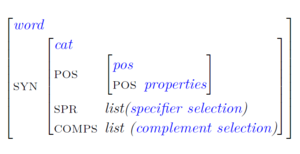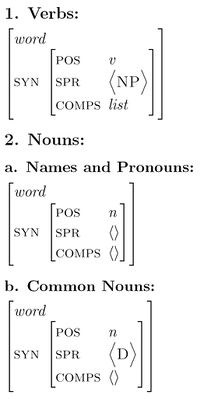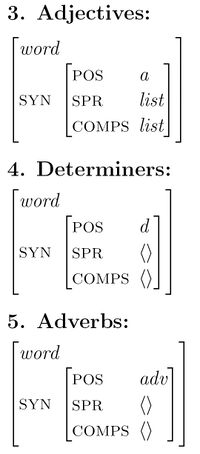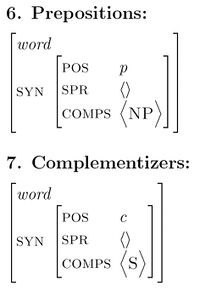Syntax 1 Wiki: Week 5
Tracking the stucture-building process in detail
This week we are going study every detail of the licensing of phrases. For this purpose, we are going to study the interaction of the following concepts:
- Word definitions
- Phrase definitions (again)
- Unification (= the merging of feature structures)
Unification
We begin with the concept of unification. It simply means that you combine the information that you have about an object from two or more sources. Or, to put it differently, you combine two descriptions of the same object. Here is an example.
The easiest way to understand unification, is to see it in action.
Pickpocket Scenario 1
Imagine that Jill and Jack are at the Frankfurt Christmas market together. At some point, they see a pickpocket stealing somebody's purse. By the time they have alerted the police, the pickpocket has disappeared. The police officer asks them for a description of the pickpocket and gets the following answers:
Jill: the pickpocket
- is a man
- has blond hair
- was wearing a jacket
- the jacket was black
Jack: the pickpocket
- is a man
- was wearing a jeans
- was wearing a jacket
- the jacket had a zipper rather than buttons
As there was only a single pickpocket, the police officer assumes that Jill and Jack are describing the same person. She gets on her radio and tells her colleagues to look out for a person meeting the following description:
the pickpocket
- is a man
- has blond hair
- was wearing a jeans
- was wearing a jacket
- the jacket was black
- the jacket had a zipper rather than buttons
10 minutes later, a man meeting this description is arrested and the stolen purse is found on him.
Pickpocket Scenario 2
The same scenario as above, just that now Jill and Jack describe the pickpocket as follows:
Jill: the pickpocket
- is a man
- has blond hair
- was wearing a jacket
- the jacket had buttons rather than a zipper
Jack: the pickpocket
- is a man
- was wearing a jeans
- was wearing a jacket
- the jacket had a zipper rather than buttons
Again, the police officer assumes that Jill and Jack are describing the same person. The combination of the informtion in their descriptions yields the following new description:
the pickpocket
- is a man
- has blond hair
- was wearing a jeans
- was wearing a jacket
- the jacket had buttons rather than a zipper
- the jacket had a zipper rather than buttons
This combined description is inconsistent, because there is no jacket that can have both of the properties in the final lines at the same time. We say that if the unification of two or more sets of information is inconsistent, then unification fails. Or, to put it differently, when unification fails, then the two descriptions cannot be unified.
Self-test exercises on unification
File:Unification-exercises.pdf
Word definitions
The second ingredient we need in order to track the details of the structure-building mechanism is word definitions.
We postulate that in order to be legitimate, every word must have the following structure:
We have seen many examples of this. There is nothing new here.
But words belonging to the same part of speech may have to meet additional constraints that distinguish them from words of other parts of speech. Here is a list of those constraints for the word of the 7 parts of speech which our grammar contains:
Valence constraints on word classes of the different parts of speech
Navigation:



